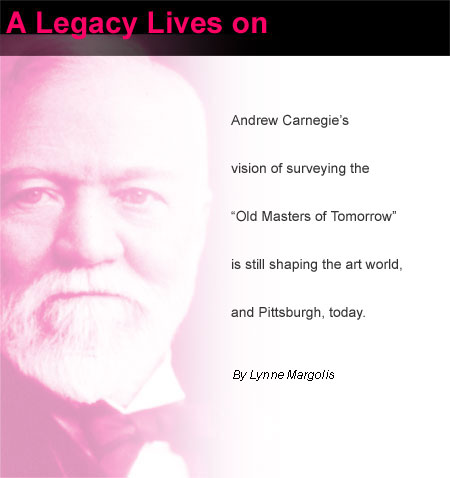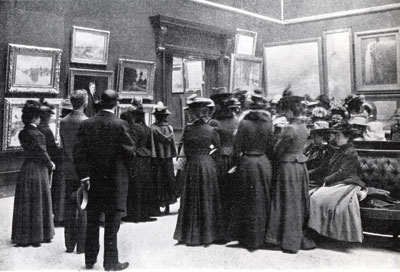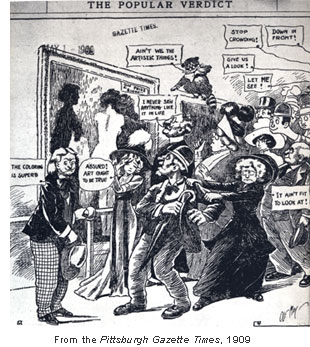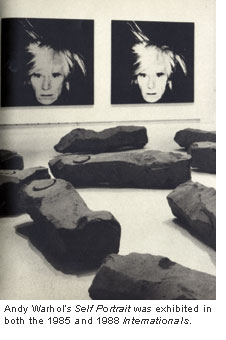
What
a different city Pittsburgh would be if Andrew
Carnegie hadn’t lived here. Without his
business acumen, his love of art, science, literature,
and music, and his belief in education, we wouldn’t
have our libraries, Carnegie-Mellon University,
or a stately home for dinosaurs and Degas. And
without his desire to create an art collection
filled with “the old masters of tomorrow,”
we wouldn’t have the Carnegie International,
the prestigious survey of modern art that draws
the world’s attention to Pittsburgh every
few years.
Trying to quantify the International’s
importance to Carnegie Museum of Art, the city
of Pittsburgh, or the art world in general is
just about impossible. But former curators,
informed art lovers, and others have much to
say about the ever-evolving exhibit, widely
regarded among modern art cognoscenti as second
in stature only to the Venice Biennale or Germany’s
Documenta, both of which are curated and presented
very differently than the International.
Former Carnegie Museum of Art
Director John Lane, who oversaw the 1982 International
and co-curated 1985’s version with the
late John Caldwell, calls it Carnegie Museums’
single most significant contribution to culture
in general. “The Carnegie International
is Pittsburgh’s great cultural legacy,”
says Lane, who left Carnegie Museum of Art to
head the San Francisco Museum of Modern Art
and is now director of the Dallas Museum of
Art. “It’s the one event in any
of the arts that occurs in Pittsburgh that the
whole world—at least, the visual arts
world—pays serious attention to.”

Madeleine Grynsztejn, who organized
the 1999 International as the Museum
of Art’s curator of contemporary art,
concurs. Both nationally and Internationally,
she says, “It’s one of the most
important indicators of our culture.
“The Carnegie International
is always looked on as a kind of prescient compilation
of the best art made anywhere,” says Grynsztejn,
now senior curator of painting and sculpture
at the San Francisco Museum of Modern Art. “It’s
used almost like a resource for the growth of
collections and exhibitions elsewhere. If you
made a study of the artists in the current International
since they’ve been asked to be a part
of the International, I guarantee their exhibition
activity has increased.”
Lane says similar artistic surveys
have come and gone, but the Carnegie International’s
more than 100-year history shows both stability
and commitment. Only one year younger than the
Venice Biennale, it’s also got the venerability
of age. “You know it will always be there
and always be important,” he says. “The
Carnegie International is not ephemeral.”
An endowment of its own, begun
in 1980—unusual for specific exhibitions—further
assures the International’s future.
“The
Old Masters of Tomorrow”
When art aficionados discuss Andrew Carnegie,
they often use the word “visionary.”
Lane calls Carnegie’s foresight atypical
for the development of an art museum. Carnegie
saw the International not only as a means of
presenting current artistic achievements to
Pittsburgh audiences—as the salons were
doing in Europe—but also as a way to bring
significant contemporary art to Pittsburgh for
possible addition to the Museum of Art’s
permanent collection.
“It was really a very insightful strategy
that Mr. Carnegie developed,” says Lane,
“and he was not an art collector. I don’t
even know that he was serious about art, not
personally, but he was serious about providing
opportunities and he was serious about developing
cultural institutions for the city of Pittsburgh.”
Former Carnegie International Co-Curator Lynne
Cooke, who, with Mark Francis, organized the
1991 International, thoroughly researched both
its history and that of its founder, and studied
“the philosophy of the whole institution.”
“Carnegie didn’t want a ‘collection’—he
wanted it to be vital and ever-changing, with
an emphasis on vanguard art, on bringing things
to Pittsburgh in a way that would be exciting
for audiences,” she says. “When
you look at the permanent collection of 20th-century
art, you can feel how the Internationals have
actually shaped Carnegie Museum of Art’s
collection, shaped the institution.”
Lane says Carnegie also wanted to differentiate
his institution from the growing art collections
of other wealthy American businessmen, including
his one-time partner, Henry Clay Frick. Most
of those men were buying European old masters.
Carnegie declared his museum would house a collection
of “the old masters of tomorrow.”
According to Sam Berkovitz, owner of Concept
Art Gallery in Regent Square, Pittsburgh, “The
International is central to the Museum of Art’s
identity. To me, it’s a wonderful opportunity
to see what’s current and what’s
important in contemporary art. I feel like I’m
cheating because it saves me countless months
of travel.”
Tom Sokolowski, director of The Andy Warhol
Museum, says the Carnegie International is really
beneficial to smaller museums for the same reason.
Many of them just don’t have the travel
budgets to traverse the world in search of art.
“This may not be as good as seeing what’s
going on Tokyo,” he says, “but if
you see a half-dozen good Japanese artists,
at least it’s emblematic of what’s
going on in Tokyo.”
Neutral
Ground
Unlike Pittsburgh’s Three Rivers Arts
Festival, which seems to have a controversy-arousing
piece of art nearly every year, the International,
according to Lane, historically has not been
“flavored” by scandal—not
even in the 1999-2000 exhibition, when the International
showcased works by British artist Chris Ofili.
Ofili’s work, which incorporates purified,
dried elephant dung, incensed then-New York
Mayor Rudolph Giuliani when Ofili’s The
Holy Virgin Mary was displayed at the Brooklyn
Museum of Art earlier in 1999.
 “I don’t think the exhibitions
that were presented early on, when Carnegie
was still alive, were in fact cutting edge,”
Lane says. “I think they were very solid,
but I think they were essentially conservative.” “I don’t think the exhibitions
that were presented early on, when Carnegie
was still alive, were in fact cutting edge,”
Lane says. “I think they were very solid,
but I think they were essentially conservative.”
A history of the International, titled International
Encounters: The Carnegie International and Contemporary
Art, 1896-1996, suggests that there were some
early “scandals” regarding presentations
of nudity, but on the whole it confirms Lane’s
assessment. Not until the 1950s and early ’60s
did the Internationals get involved with what
Lane terms “advanced visual arts,”
i.e., abstraction.
By all accounts, the International slipped
in quality and importance in the ’70s
and early ’80s, but since 1985, says Lane
with a laugh, “It has been an exhibition
about the leading edge, although perhaps not
the bleeding edge.
“One of the particular virtues of having
this show in Pittsburgh is that it isn’t
a city that’s a lightning rod for cultural
controversy,” he adds. “A lot of
artists have historically enjoyed the invitation
to show in Pittsburgh because it’s neutral
ground. It isn’t like showing in one of
the great art capitals of the western world.
The environment is different. It’s not
under the radar, because people are certainly
cognizant of what happens there. It’s
just that it’s not a blood sport in Pittsburgh.”
He notes Pittsburghers tend to be open-minded
about art, a trait they may have cultivated
over a century of Internationals. Instead of
dismissing new, different, strange—and
perhaps disturbing—work, they’re
interested in learning first, then forming an
opinion. The Andy Warhol Museum’s well-attended
exhibitions, Without Sanctuary: Lynching Photography
in America, and new Inconvenient Evidence: Iraqi
Prison Photographs from Abu Ghraib, reinforce
that theory.
Grynsztejn says the International’s success
hinges on compelling, accessible material, but
also on an audience “that is interested
and curious and intelligent, not necessarily
expert and empathetic.”
Western Pennsylvanians have always turned out
for Internationals, whether they really “know”
art or not. That’s a testament to the
community’s appreciation for what Lane
calls “this cultural endeavor and the
pleasures and provocations that one experiences
when coming to see it.”
Kilolo Luckett, a University of Pittsburgh
graduate in art history who does “know”
art, describes the International’s impact
on the regional art community as multi-layered.
Besides the opportunities it provides for art
institutions, galleries, and individual artists
to interact, she says, “The International
brings fresh, cutting-edge, contemporary work
that engages me on a visceral and intellectual
level. It creates a ‘hyper’ synergy
and awareness that pulsates and enlivens the
city.”
Luckett was a curatorial assistant at the Wood
Street Galleries and a publicist at Pittsburgh
Filmmakers before joining Cool Space Locator,
a non-profit real estate company. She loved
the fact that the 1991 International involved
other locations, including the Mattress Factory
on the North Side, which was the site of four
installations, and the fact that she could interact
with the artists and art critics at various
International-related events.
 One North Side institution—The Andy Warhol
Museum—might not be in Pittsburgh if not
for the International, Lane suggests. He theorizes
that the ’85 and ’88 Internationals
proved Pittsburgh’s devotion to showing
“the greatest works of our time”
—including, in ’88, a series of
Warhol’s self portraits. One North Side institution—The Andy Warhol
Museum—might not be in Pittsburgh if not
for the International, Lane suggests. He theorizes
that the ’85 and ’88 Internationals
proved Pittsburgh’s devotion to showing
“the greatest works of our time”
—including, in ’88, a series of
Warhol’s self portraits.
Warhol studied art at Carnegie Museum of Art,
he exhibited there, he was born in Pittsburgh.
All these were factors in considering whether
The Warhol would wind up in Pittsburgh. But
Lane says the International proved to the Warhol
Foundation and the Dia Center for the Arts,
both of whom would decide where the museum would
be located, that Carnegie Museum of Art was
a peer institution and that the city took contemporary
art seriously.
“It would be my sense that one of the
legacies of Andrew Carnegie’s invention
of this exhibition and the institution’s
perpetuation of it over a century is that it
made Pittsburgh a serious candidate for having
this incredibly great, incredibly important
one-person museum,” says Lane.
A
Major Attraction
When discussing the International’s effect
on Pittsburgh and its people, the tourism factor
must be considered as well. The International
does bring its share of visitors to the area.
Tinsy Lipchak, director of tourism and cultural
heritage at the Greater Pittsburgh Convention
& Visitors Bureau, says, “People who
are in the know about contemporary art come
here specifically to see the International.
It does have its place in the scene, and not
just for high art/contemporary art aficionados,
but for the average tourist who wants to see
something cutting-edge.”
Those who visit for the first time are inevitably
surprised by how many other attractions the
city has to offer, she says. The hard-core International
art community shows up to party —and to
shop — during the opening weekend.
Says Grynsztejn, “The opening is not
only very good-looking and filled with the latest
fashions, it’s also filled with artistic
bounty hunters. Every collector, every museum
director, and every curator worth his or her
salt is going to that opening on the lookout
for things they can acquire because 2004 International
Curator Laura Hoptman will have done this incredible
groundwork on their behalf.”
Grynsztejn can’t say enough about the
experience of overseeing an International.
“The International hones you, it hones
your curatorial skills like very little else
can,” she says. “Carnegie Museum
of Art has acted as a sort of Harvard of the
curatorial world. One of the things that I don’t
think it’s touted for enough is that it
trains the curatorial field and produces the
best curatorial minds, who then go out and influence
institutions nationwide.”
Each International opening is also an alumni
gathering of sorts for former curators. “I
look forward to it every time,” Grynsztejn
says. “I look forward to it as a way of
learning even now. It’s the best show
in the country.
“Andrew Carnegie did the right thing.”
Back to Contents |